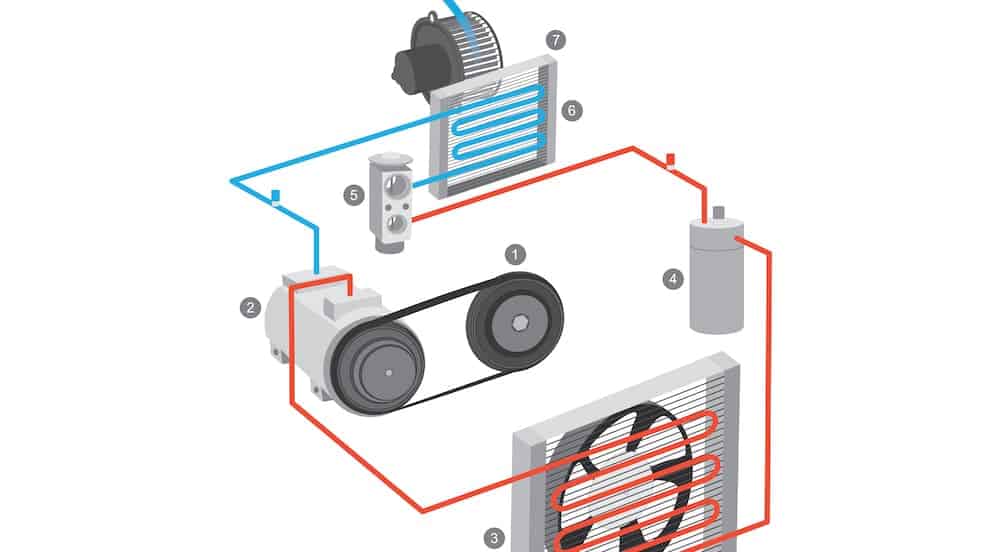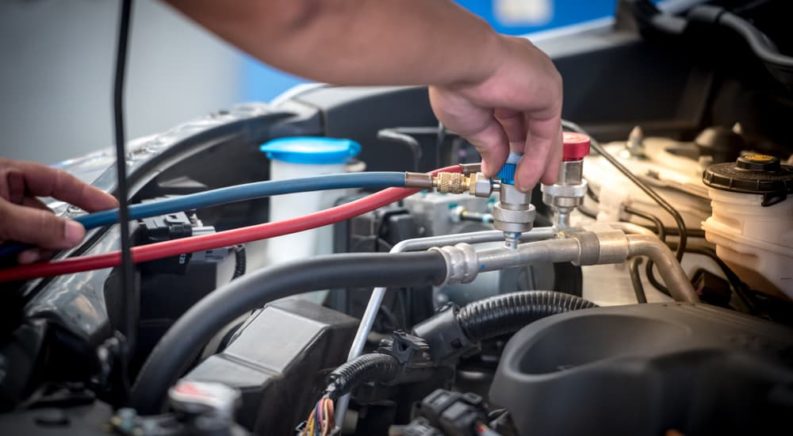Air conditioners are amazing and beneficial devices, especially when they are installed in automobiles. They keep you feeling cool while driving during those hot summer days. Air conditioners also dehumidify the air inside of the vehicle, which can be particularly useful should you find your widows suddenly fogging up.
Depending how long you keep your car, there will come a time when you may need to look up “automotive air conditioner repair” on the web. There is nothing worse than driving in the middle of the night with already limited visibility and having your window fog up. It can turn any drive into a dangerous one by obscuring your vision, which is particularly important for something like driving. Window wipers cannot help if the condensation is forming on the inside of the vehicle, which is where a fully functioning automotive AC unit comes in to play. While the cold air is refreshing, especially in warmer climates, it is still a luxury and is not technically necessary for driving. On the other hand, being able to de-fog your widow when there is humidity outside is absolutely vital.
Automotive air conditioners have existed for quite a while, and have become much more refined and efficient over the years. However, there are still quite a few different issues that can come from an automotive air conditioner. Seeing as this is true, it’s advised to learn the signs if your vehicle’s AC unit is running correctly or not. Instead of paying a mechanic to repair your AC, which can be a very costly affair, there are a few different things you can do from home to fix the problem.
History of Automotive Air Conditioners
Air conditioners themselves, or more so the theory of air conditioning has existed since ancient times. Some of the first known forms of air conditioning come from Ancient Egypt, where some Egyptians would hang reeds in their windows and dampen them with water. The evaporation of the water from the reeds would release cool air, which was blown into the buildings by air entering the windows. Not only cooled down their homes but also dehumidified them, which was very useful for people living in a desert. Eventually, people began harvesting ice during the winter and storing it to sell in the summer. People would set a large block of ice in a tub, and set a fan in front of it. This would again not only cool down the building but also dehumidify the often stale and dry air. The air conditioner as an electronic device was invented in 1902 by a US inventor named Willis Carrier. He initially designed his air conditioning unit to aid in solving an application problem for the Sackett-Wilhelms Lithographing and Publishing Company in Brooklyn, New York. He used his knowledge of heating things with steam and reversed it. Instead of sending air through hot coils, he sent them through cold coils, which were filled with cold water. This not only allowed him to control the temperature, but also the humidity levels in the room, which allowed for more consistent paper dimensions and ink alignment. Over time, his technology was implemented to improve worker productivity, and he eventually founded the Carrier Air Conditioner Company of America as demand for his air conditioner unit increased.
The first automotive air conditioner arrived in 1939, but its production was rather short-lived. Released by the company Packard for their vehicles starting in 1939, and it also included a heater option. However, these units took up nearly half of the available trunk space, required several feet of plumbing between the engine and the trunk, and were very costly for the average vehicle owner at the time. This unit was eventually discontinued in 1941, and automotive air conditioners disappeared for over a decade. Then in 1953, Chrysler released the Imperial along with the Chrysler Air-temp as an option. This unit was a marked improvement over its predecessors. Multiple different vehicle makers then released their own air conditioner units for vehicles, causing them to explode in popularity. By 1969, over 50% of all vehicles in the United States came with air conditioners.
How Automotive Air Conditioners Work
Three main components make up an AC system; a compressor, a condenser, and an evaporator. These components work together along with smaller components to keep the air cool and flowing. The compressor is a pump which is driven by a belt that attaches to the engine’s crankshaft. It draws in refrigerant, which is in a gaseous form, and compresses it under heavy pressure, and forces it into the condenser. The condenser is essentially just a radiator and operates very similarly to the one that comes in a vehicle by radiating heat out of the system. When the gaseous refrigerant is moved to the condenser from the compressor, it creates a large amount of heat, which is dissipated as air flows around the twisting tubes. This causes the refrigerant to condense back into a liquid form, sort of like steam condensing into water. This liquid refrigerant is moved along through a few smaller components, such as the receiver and the thermal expansion valve. This is where any additional water that may have made it through is removed. The refrigerant than finally reaches the evaporator, where it is a cold condensed liquid at 32°F. The evaporator is located in the cabin of the vehicle, usually above the footwall of the passenger side. The heat from the cabin of the vehicle is enough to make the refrigerant boil, which causes it to revert back into a gaseous state. Once it becomes a gaseous state, it can absorb a large amount of heat. Gaseous refrigerant then flows out of the evaporator, and out of the passenger cabin, which then takes all heat along with it. A fan blowing along the outside of the evaporator coils blow cold air into the cabin. The refrigerant then flows back into the compressor to begin the process again.

What to Look For/How to Repair
While certain issues need professional help, there are a few different things that you can do from home to identify an issue in your vehicle’s air conditioner, as well as solve them. One of the first and most obvious signs that your car’s AC unit is not functioning correctly, is if the air conditioner is blowing out warm air. While this could happen because of a few different issues, the common problem is that the AC system needs to be recharged. Over time, an AC unit will lose refrigerant and will need to be recharged with more. You can buy small recharge kits from various automotive shops or Walmart; however, if this does not solve the issue, it may be indicative of a leak.
You can determine whether or you have a leak and even the location of the leak by using a leak detection kit. This will include a UV spray that you put into the system. By using a UV light and looking for the color of the spray, you can determine where the leak in your ac unit is. If the leak is too much to be handled from home, call your local mechanic to help fix the issue.
In today’s modern cars, they all come with AC standard. Its a simple but yet complex system that we forget about until its the hottest day of the summer. Before it does get to those summer months, remember to check and fix any AC repairs right away.

